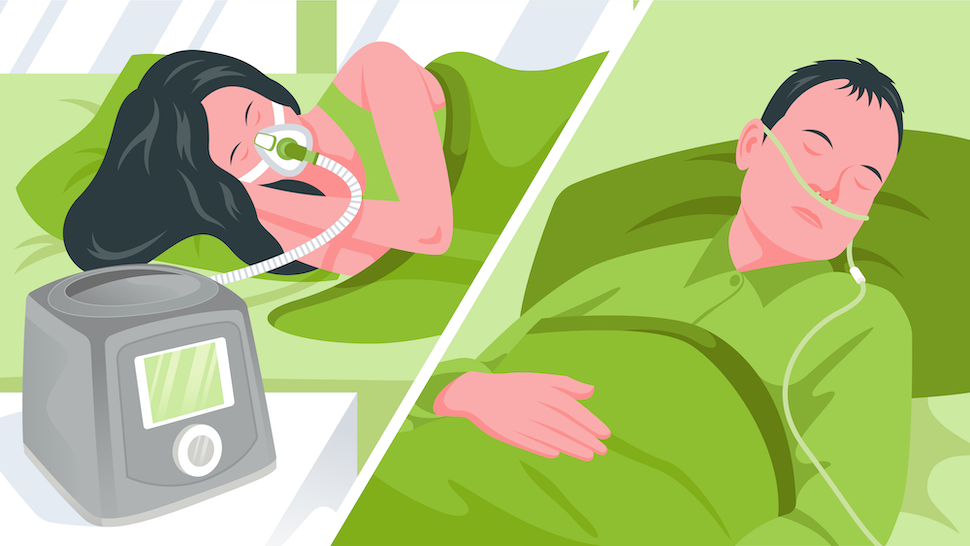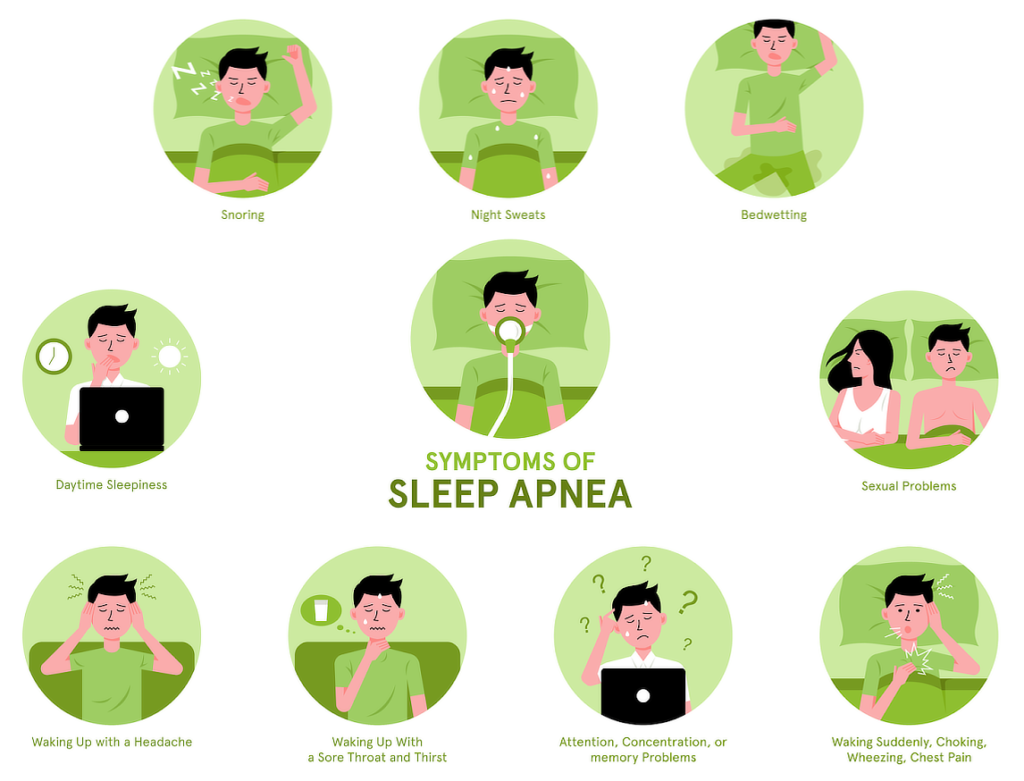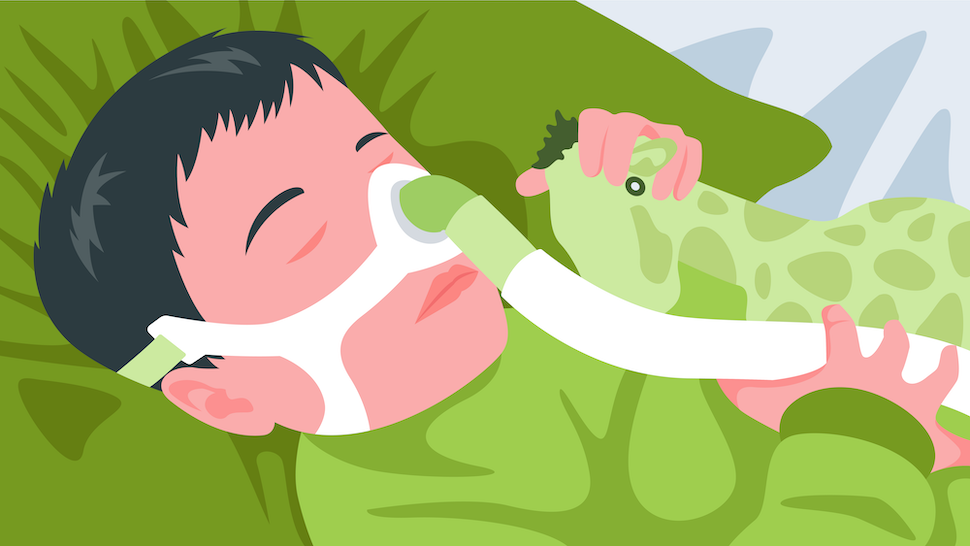An overview of the typical side effects and symptoms of sleep apnea in kids and adults
Sleep apnea impacts a surprising portion of people around the world.
But the fact that it takes place in your sleep can make detection tricky—especially if you live or sleep alone!
Given the serious health consequences sleep apnea can cause, proper detection and treatment can make a massive difference in the quality of life and overall health of anyone experiencing this increasingly common condition.
Understanding the tell-tale signs and symptoms of sleep apnea is a critical element in detection and starting the diagnosis process.
This guide will look at the common side effects and symptoms of sleep apnea for adults and children to help you monitor your health and make informed decisions.
The Importance of Knowing Sleep Apnea Side Effects & Symptoms
Before diving into the side effects and other details, we want to take a big picture look at sleep apnea and its impact on Canada and the rest of the world so you can understand the prevalence of this often-untreated condition.
According to a 2018 study published at the American Thoracic Society International Conference, an estimated 1 billion people worldwide are living with sleep apnea—roughly 1-in-7 people on the planet.
The Sleep Apnea Society of Canada estimates that approximately 10 million Canadians have sleep apnea.
More surprisingly, they believe that 80 to 90 percent of those cases are likely undiagnosed.

This is because mild and even moderate sleep apnea might go unnoticed.
Even when it is noticed, going through the process of diagnosing your sleep apnea might feel like a daunting process.
Further complicating things, adults and children can exhibit symptoms differently due to differences in daily routines and expectations.
While at-home sleep studies have come a long way in improving accessibility to PAP therapies, areas where lab-based studies are mandatory are often underserved, according to an analysis by the Respiratory Society of Ontario.
In 2020, they reported that provinces averaged only two beds per 100,000 people.
This can lead to long wait times for lab-based tests and cause people to avoid seeking testing or treatment.
However, many don’t know that at-home testing is possible in many provinces and that doctors can take steps to address symptoms even before testing if you must wait for a lab opening.
If you suspect you or someone you love might be living with sleep apnea, keep reading and compare your experience with the side effects and symptoms listed below.
NOTE: This guide is intended as an educational resource to help you understand common sleep apnea issues and make informed decisions about seeking professional medical treatment. It is no way to be considered professional medical advice. Always consult your primary care provider or a qualified sleep specialist if you suspect you are dealing with sleep apnea symptoms.
Side Effects and Symptoms of Adult Sleep Apnea
Adult sleep apnea can cause a range of health issues and side effects.
While they might often start as minor symptoms quickly explained away, they often compound and intensify, causing increased discomfort and lower quality of life as they are left untreated.
This section will look at common symptoms and side effects you might experience.
As with any online medical resource, you shouldn’t use this information to self-diagnose.
However, if you frequently experience one or more of these symptoms, consider speaking with your primary care provider to determine if further investigation should be considered.

Daytime Sleepiness or Attention, Concentration, and Memory Problems
Even if your apnea episodes only last a second or two, they interrupt your sleep cycle, making restorative sleep hard to reach.
While you might not remember waking up during the night, you’ll likely begin to notice the impact on your ability to wake in the morning and your energy levels throughout the day.
If you’re getting typical amounts of sleep for your needs but never truly feel rested, it might be time to reach out to your doctor or sleep specialist.
Waking Up with a Headache
One of the most common complaints from people with sleep apnea is waking with a headache, and researchers are still unsure exactly why these headaches occur.
While many speculate that the headaches are related to oxygen deprivation, research has shown that apnea patients with and without headaches typically have comparable blood oxygen levels.
However, if you experience frequent headaches upon waking that feel more like a constant pressure than a pulsing and that resolve on their own after a few hours, you might want to speak with your doctor about your symptoms.
Waking Up with Sore Throat and Thirst
If you spend your night fighting to breathe due to airway obstruction and switch to breathing through your mouth, there’s a good chance that it will lead to a parched mouth, a sore throat, and thirst.
While these aren’t necessarily indicators on their own, if you frequently experience them alongside other symptoms, a sleep study and medical intervention could be needed.
Loud Snoring
This symptom often comes alongside the previous one.
Fighting to keep your airways open as you sleep will typically cause vibrations, leading to loud, excessive snoring.
This is one of the major reasons why sleep apnea is often first noticed by someone’s partner.
If you’re not experiencing congestion or another respiratory illness and your partner keeps waking you in the night or moving to another room, snoring could be an indicator of something larger—such as sleep apnea.
Gasping, Choking, or Wheezing While Sleeping
Often, once your airway becomes blocked, you’ll stop breathing.
As your body realizes that oxygen is no longer replenishing as expected, it will jolt your system into breathing again using a stronger-than-usual breath or bodily jerks.
These typically lead to gasps, choking, wheezing, or an abruptly loud snore after a long silence.
This is another symptom often noticed by partners unless they are severe.
You may not wake enough to remember them in the morning.
Excessive Nighttime Urination or Bedwetting
According to Sleepapnea.org, 84% of people they polled regarding their sleep apnea reported taking multiple trips to the bathroom each night to empty their bladder.
In some cases, apnea patients can even fail to notice the signals they need to use the bathroom in their sleep, leading to bedwetting.
If you’re experiencing these issues, consult your primary care provider, as frequent urination can be a symptom of many concerns.
Other Symptoms and Side Effects to Monitor
There are other symptoms and side effects that are less frequent or, perhaps, less noticeable without medical intervention or monitoring.
However, they’re no less serious.
Discuss the possibilities with your doctor if you experience any of the symptoms below.
- Nightsweats and poor temperature regulation while sleeping
- Hypertension
- Unexplained heartbeat irregularities
- Stroke
- Unexplained Type 2 Diabetes
- Metabolic syndrome
- Abnormal liver function panels
Side Effects and Symptoms of Pediatric Sleep Apnea
While the outcomes for children experiencing sleep apnea are similar to adults, some of the notable signs or side effects of pediatric sleep apnea differ due to differences in lifestyles and daily routines.
For example, many children sleep alone.
So unless you check on your child frequently throughout the night, you may not notice snoring, gasping, choking, or breathing rhythm inconsistencies.
This doesn’t mean symptoms aren’t occurring, simply that they’re often harder to detect without constant monitoring.

Other side effects that kids and adults share include:
- Waking with a sore throat, excessive thirst, or headache
- Daytime sleepiness or attention, concentration, and memory problems
- Excessive nighttime urination or bedwetting
However, other symptoms to watch out for include:
- Sleeping in odd positions
- Sleep talking or sleepwalking
- Bad dreams or nightmares
Since children are often unmonitored while they sleep, it’s more likely that their sleep apnea side effects will be noticed during the day—be that by parents, siblings, teachers, daycare providers, or friends.
Further complicating matters, many side effects can be mistaken for other conditions or even simply dismissed as typical child or teen complaints.
If you notice any of the following combined with nighttime symptoms from above, speaking with their pediatrician is highly recommended to rule out any possibilities of sleep apnea in kids.
Behavioural Changes or Outbursts
Sleep apnea can create significant issues with daytime drowsiness, focus levels, and mood.
In high-pressure environments—such as modern schools—kids will often exhibit behavioural changes when dealing with apnea symptoms for extended periods.
This can also lead to uncharacteristic behaviours and rapid mood shifts, such as anger or outbursts, in otherwise calm and patient children as they become frustrated with the struggle of keeping up with expectations while having no apparent reason why they might be struggling.
Difficulty Paying Attention or Uncharacteristic Learning Difficulties
If your child is suddenly experiencing issues with focus or comprehending inputs during the school day, this could be a sign of sleep apnea.
Of course, these are also common signs of various mental health or neurodivergent concerns, so a discussion with your pediatrician and potential follow-up with a psychologist is likely to help limit possible causes and help your child get back on track.
Uncharacteristic Drowsiness or Restlessness
If your child appears to get plenty of sleep but never appears to be rested or has issues falling asleep during the day, it could be a sign of sleep apnea.
Likewise, children with sleep apnea use shuffling, fidgeting, and other means to help fight off sleep, improve focus, and otherwise try to minimize the impact of any mental fog or fatigue caused by their lack of sleep.
Unexplained Failure to Thrive or Fluctuations in Weight
Children with moderate-to-severe sleep apnea often struggle to gain weight or may see rapid shifts in weight as symptoms wax and wane throughout the year.
If you cannot link these symptoms to nutritional or lifestyle sources, talk with your pediatrician to rule out any sleep apnea concerns.
What to Do If You Expect You or Someone You Know is Experiencing Sleep Apnea Symptoms
As with any medical concern, your primary care provider is the best person to help you create a plan to deal with sleep apnea.
In many cases, they’ll be able to give you an at-home sleep apnea test to diagnose or rule out your concerns quickly.
However, in some areas, these aren’t allowed.
In that case, your doctor could refer you to a sleep specialist for a lab-based sleep study.

We never recommend attempting to diagnose your sleep apnea or treat your sleep apnea yourself.
All reliable and safe sources of sleep apnea equipment require a prescription for purchase.
Perhaps more importantly, CPAP machines must have their pressure set based on your apnea symptoms.
Using unauthorized devices without personalized settings can cause more harm than good!
Key Takeaways
- An estimated 1 billion people experience sleep apnea symptoms worldwide—including up to 10 million Canadians!
- Many cases of sleep apnea go undiagnosed and untreated.
- Presentation of sleep apnea symptoms can differ between children and adults.
- Symptoms and side effects of adult sleep apnea include daytime sleepiness; attention, concentration, and memory problems; waking up with a headache; waking up with a sore throat; waking up with excessive thirst; loud snoring; gasping, choking, or wheezing while sleeping; excessive nighttime urination or bedwetting; night sweats; hypertension; heartbeat irregularities; stroke; type 2 diabetes; metabolic syndrome; and abnormal liver function panels.
- Children’s sleep apnea is often overlooked as they sleep alone and present symptoms in ways which others might mistake for other physical or mental health concerns.
- Symptoms and side effects include waking up with a headache; waking up with a sore throat; waking up with excessive thirst; daytime sleepiness; attention, concentration, and memory problems; excessive nighttime urination or bedwetting; sleeping in odd positions; sleep talking; sleepwalking; bad dreams or nightmares; behavioural changes or outbursts; difficulty paying attention or uncharacteristic learning difficulties; uncharacteristic drowsiness or restlessness; and unexplained failure to thrive or fluctuations in weight.
- If you believe you or someone you know is experiencing the effects of sleep apnea, consult with your primary care provider or pediatrician immediately.
- Diagnosing sleep apnea is typically easy—requiring an at-home or lab-based sleep test.
- Never buy secondhand CPAP equipment and attempt self-treatment without a prescription.
- CPAP machine settings are personalized to adjust to your exact needs. Using improper settings can create additional health risks and minimize any benefits you might see.
CPAP Supply is a leading online provider of CPAP equipment and accessories in Canada for customer service. If you discover that you or someone you know is experiencing sleep apnea symptoms, we’d love to help you build a CPAP machine package to suit your needs. Call us today to discuss options!
References
- Mayo Clinic: Sleep Apnea
- Mayo Clinic: Obstructive Sleep Apnea
- WebMD: Sleep Apnea
- Cleveland Clinic: Sleep Apnea
- Johns Hopkins Medicine: The Dangers of Uncontrolled Sleep Apnea
- Healthline: The Effects of Sleep Apnea on the Body
- Mayo Clinic: Pediatric Obstructive Sleep Apnea
- Cedars Sinai: Obstructive Sleep Apnea in Children
- Healthline: Sleep Apnea in Children: What You Need to Know
- Respiratory Therapy Society of Ontario: Obstructive Sleep Apnea: Are Canadians Underdiagnosed and Undertreated?
- Nature: A Portrait of Obstructive Sleep Apnea Risk Factors in 27,210 Middle-Aged and Older Adults in the Canadian Longitudinal Study on Aging
- International Journal of Environmental Research and Public Health: Prevalence of Obstructive Sleep Apnea Syndrome: A Single-Center Retrospective Study
- American Thoracic Society 2018 International Conference Abstracts: Global Prevalence of Obstructive Sleep Apnea in Adults: Estimation Using Currently Available Data
- SleepApnea.org: Nighttime Urination and Sleep Apnea
